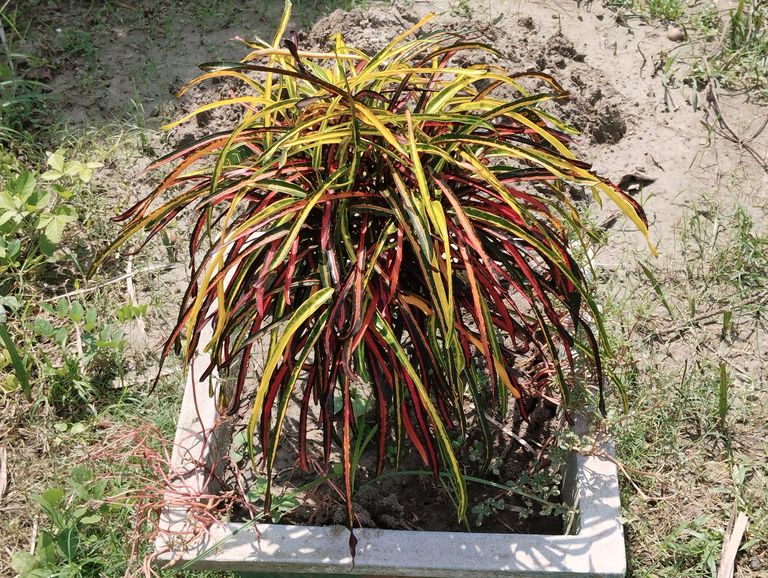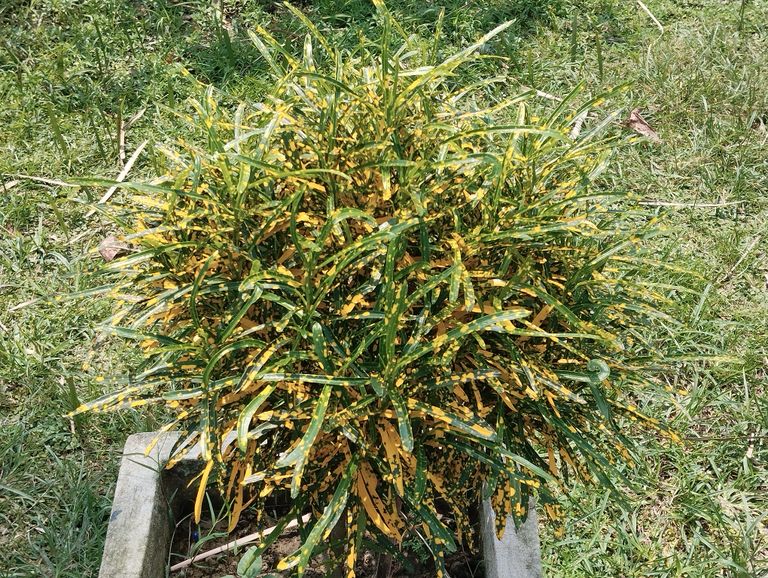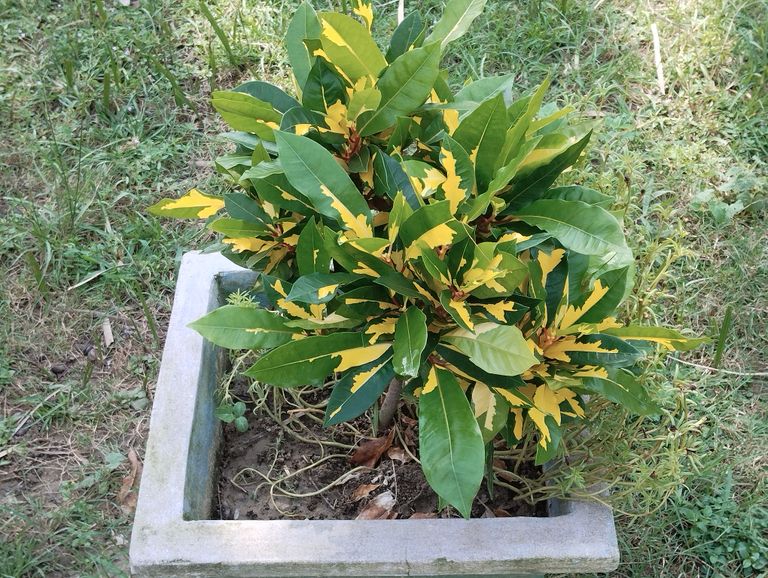The Beauty of Croton Flowers: A Vibrant Addition to Nature’s Palette.

Nature’s ability to mesmerize us with its diversity is nothing short of magical. Every tree, shrub, and flower plays a part in creating the vivid landscape that we see all around us. Among the plethora of plant species that grace our gardens and homes, the Croton plant, also known as “Pata Bahar” in many parts of the world, stands out. Its striking leaves and sometimes subtle flowers have garnered admiration from nature lovers. While the plant is primarily known for its colorful foliage, the Croton flower, in its subtlety, has its unique charm that adds to the plant’s overall appeal.
A Glimpse Into Croton’s Unique Identity
The Croton plant belongs to the Euphorbiaceae family and is native to tropical regions. It is highly celebrated for its vibrant, multicolored leaves that can be found in hues of red, yellow, green, and even orange. The plant's name, Codiaeum variegatum, might be less known than its common name, Croton, but its popularity is widespread due to its stunning appearance.
Most people associate the Croton plant with its colorful leaves, but fewer are aware that it also produces flowers. While these flowers may not be as showy as those of some other plants, their delicate beauty is a subtle reminder of nature’s understated elegance.
The Delicate Beauty of Croton Flowers
Croton flowers are quite small and grow in clusters on long stems. They are typically found in white, cream, or pale yellow shades. The flowers are either male or female and grow on the same plant but on different parts of the stem. Male flowers are usually small and have a more feathery appearance, while female flowers are slightly larger and rounder.
While the flowers themselves are not the primary attraction of the Croton plant, they contribute to its overall beauty. The small blossoms, coupled with the large and bold leaves, create a harmonious contrast that emphasizes the plant’s diversity. The sight of Croton flowers in bloom adds an additional layer of texture to the already vibrant plant, making it an even more striking centerpiece in gardens and homes.
Seasonal Blooming and Growth Habits
Croton flowers usually bloom during the warmer months, particularly in tropical and subtropical regions where the climate is conducive to their growth. The plant thrives in warm temperatures and needs plenty of sunlight to maintain its bright foliage and to encourage flower growth.
When placed outdoors, Croton plants can reach heights of up to 10 feet, and in such environments, their flowers are more noticeable. However, when grown indoors or in pots, the plant tends to be more compact, and the flowers, though still present, may be less prominent.
The flowering of the Croton plant is a subtle event compared to its colorful display of leaves, but it provides a different kind of beauty—a soft and understated charm that complements the boldness of its foliage.
Croton as a Symbol of Boldness and Elegance
In the world of horticulture, Croton plants symbolize a balance between boldness and elegance. While their leaves are vibrant and demand attention, their flowers are gentle and modest. This contrast mirrors the complexities of nature itself—how something can be both striking and serene at the same time.
The plant's resilience is another aspect of its beauty. Despite its delicate flowers, the Croton is a hardy plant that can adapt to different environments, as long as it is provided with the necessary warmth and light. This adaptability makes it .


The Charm of Hill Flower Cultivation: A Blooming Future
Flower cultivation in hill regions is a beautiful convergence of nature's gifts and human ingenuity. These picturesque landscapes, with their unique climate and soil conditions, provide ideal settings for cultivating some of the most exquisite and sought-after flowers in the world. From the valleys of the Himalayas to the serene slopes of the Western Ghats, hill regions in India and beyond have nurtured a vibrant floral economy that not only supports livelihoods but also adds color to our lives. In this blog, we’ll delve into the intricacies of hill flower cultivation, its benefits, challenges, and its potential to bloom into a sustainable industry.
Why Hills are Ideal for Flower Cultivation
Flower farming in hill regions is different from that in the plains due to the distinctive climatic and geographic conditions. The following factors make the hills ideal for growing flowers:
Cool Climate: Many flowers thrive in cooler climates. The temperature in hill areas remains moderate throughout the year, which is suitable for flowers like lilies, carnations, and roses. Cooler temperatures also ensure a slower, more sustained growth period, which can enhance the quality and longevity of flowers.
Rich Soil: Hills often have loamy and well-drained soil, which is perfect for flower cultivation. The natural fertility of the soil, enriched by the decaying organic matter from the surrounding vegetation, provides a nutrient-rich environment conducive to the healthy growth of plants.
Adequate Rainfall: Most hill regions receive consistent rainfall, which ensures a steady water supply for the flowers. However, well-drained soil prevents waterlogging, a common issue in other parts of the world.
Natural Light: The elevated positioning of hills allows flowers to receive an optimal amount of sunlight, crucial for photosynthesis. This leads to healthier plants and brighter, more vibrant blooms.
Pest-Free Environment: The cooler temperatures in the hills discourage the proliferation of many common pests, reducing the need for pesticides and other harmful chemicals.
Popular Flowers Grown in Hill Regions
A wide variety of flowers are grown in hill regions, each with its own set of specific growing requirements. Some of the most popular and commercially viable flowers include:
Roses: Known as the queen of flowers, roses are grown extensively in hilly areas due to the cool climate, which ensures longer-lasting blooms. Hill roses, especially from regions like Ooty and Darjeeling, are highly valued for their vibrant colors and fragrance.
Lilies: Lilies thrive in hill stations like Shimla and Manali. Their striking beauty and wide range of colors make them a favorite for florists and gardeners alike.
Carnations: Carnations are another commercially successful flower grown in hilly regions. Their delicate petals and long shelf life make them ideal for both local and international markets.
Gerberas: Gerbera daisies, with their bright and cheerful colors, are widely cultivated in the hills. They are used extensively in bouquets and floral arrangements due to their vibrant hues and large flower heads.
Chrysanthemums: These flowers, symbolizing longevity and joy, are grown in cooler climates. The variety in colors and forms makes chrysanthemums a staple in the flower markets.
Orchids: Hills, especially in the northeastern part of India, are renowned for their exotic orchids. These flowers are highly valued in the ornamental plant industry and are often exported to international markets.
Benefits of Hill Flower Cultivation
The cultivation of flowers in hill regions is not only aesthetically pleasing but also offers numerous socio-economic and environmental benefits.
1. Economic Upliftment
Flower farming is a significant source of income for many hill communities. In places like Himachal Pradesh, Sikkim, and Uttarakhand, where traditional farming might be challenging due to the steep terrain, flower cultivation has provided an alternative livelihood. The increasing demand for high-quality flowers, both domestically and internationally, has made floriculture a lucrative industry. Flowers are exported to urban centers, hotels, events, and even foreign countries, boosting the local economy and providing employment to many, especially women.
2. Environmental Conservation
Flower cultivation can promote sustainable agricultural practices. Since many flowers thrive in organic conditions, the need for chemical fertilizers and pesticides is reduced, making flower farming eco-friendly. Additionally, the cultivation of flowers on terraced slopes prevents soil erosion, a common problem in hilly areas. The diverse plant cover also contributes to maintaining the ecological balance of the region.
3. Tourism Boost
Hills covered in blooming flowers attract tourists from around the globe. Flower festivals, gardens, and nurseries have become key attractions in regions like Munnar, Ooty, and Darjeeling. These festivals not only promote the local culture and traditions but also provide a platform for local flower growers to showcase their produce.
Challenges in Hill Flower Cultivation
While hill flower cultivation has numerous advantages, it is not without challenges. Some of the common issues faced by flower farmers in these regions include:
1. Limited Access to Markets
Hill regions often suffer from poor infrastructure, making it difficult for farmers to transport their flowers to larger markets. The perishable nature of flowers means they must reach markets quickly to avoid losses, and inadequate transportation facilities often result in post-harvest losses.
2. Weather Dependency
While the cool climate is generally beneficial, unpredictable weather patterns, such as heavy rains, hail, or frost, can destroy entire flower crops. Climate change is making these weather patterns even more erratic, posing a risk to flower cultivation.
3. Lack of Advanced Technology
Flower cultivation in hills is still largely dependent on traditional methods. There is a lack of access to advanced farming techniques, such as controlled environment agriculture (greenhouses), which could help farmers increase their yields and improve the quality of their produce.
4. Pests and Diseases
Though the cool climate limits the growth of many pests, certain flowers are still susceptible to diseases like powdery mildew and fungal infections. Lack of awareness about effective pest and disease management can lead to crop losses.
5. High Initial Investment
Setting up a flower cultivation business, especially in hilly areas, requires a significant initial investment. Greenhouses, irrigation systems, and quality seeds are costly, and small farmers often struggle to afford these resources without government or financial support.
Steps Towards Sustainable Growth
Despite the challenges, the future of flower cultivation in hilly regions is bright. With the right interventions, this industry can be a model of sustainable agriculture. Some of the steps that can be taken to promote the growth of floriculture in the hills include:
Improved Infrastructure: Developing better road networks and cold storage facilities would help farmers transport their flowers to markets more efficiently and reduce post-harvest losses.
Training and Education: Providing farmers with training on advanced cultivation techniques, such as greenhouse farming, organic practices, and disease management, can increase productivity and the quality of flowers.
Government Support: Subsidies for equipment, seeds, and fertilizers, as well as financial aid for small-scale farmers, can encourage more people to take up flower cultivation. Additionally, promoting floriculture under rural development schemes can provide much-needed financial and logistical support.
Promotion of Floriculture Tourism: By promoting flower festivals and gardens, hill regions can attract more tourists, thus creating a dual stream of income for flower farmers. The development of flower-based tourism infrastructure would create additional jobs and boost the local economy.
Research and Development: Encouraging research in the field of floriculture to develop disease-resistant varieties and improving the yield through better farming practices is crucial. Establishing floriculture research centers in hill regions can contribute to this effort.
Conclusion
Hill flower cultivation is not only an economically viable venture but also an environmentally sustainable one. With the right support, training, and infrastructure, it has the potential to transform the lives of hill farmers and contribute significantly to the global floriculture industry. As consumers continue to seek eco-friendly and organically grown products, hill flowers, nurtured in nature's lap, can offer the world a beautiful and sustainable choice.
In the coming years, we can expect the hills to bloom even brighter as flower cultivation blossoms into a thriving industry.



The Benefits of Croton Plant (Pata Bahar)
Croton, commonly known as Pata Bahar in many parts of South Asia, is a popular ornamental plant known for its vibrant, colorful leaves. With its striking appearance, the croton plant is often used to enhance the beauty of gardens, homes, and offices. But beyond its aesthetic appeal, Pata Bahar offers several benefits, both environmental and medicinal. In this blog, we will explore the various advantages of this fascinating plant.
1. Aesthetic Appeal and Landscaping
One of the most apparent benefits of the croton plant is its visual appeal. Pata Bahar’s brightly colored leaves, ranging from green to yellow, orange, red, and even purple, make it an attractive addition to any garden or indoor space. The plant's ability to thrive in different climates makes it a popular choice for gardeners looking to add a splash of color to their surroundings. Whether planted in garden beds, potted indoors, or used as a decorative element on patios, crotons elevate the beauty of any space.
Benefits:
- Enhances the beauty of homes, offices, and gardens.
- Offers a variety of colors and patterns to suit different design preferences.
- Low-maintenance for landscaping, requiring only minimal care to thrive.
2. Air Purification
In addition to its beauty, the croton plant contributes to a healthier living environment by improving indoor air quality. Like many houseplants, croton plays a role in filtering pollutants and toxins from the air, helping to create a cleaner, fresher atmosphere in your home or office. This makes it an excellent addition to indoor spaces, particularly in urban environments where air quality can be a concern.
Benefits:
- Helps purify indoor air by removing harmful pollutants.
- Contributes to a cleaner, more breathable environment.
- Ideal for homes in polluted or industrial areas where air quality is compromised.
3. Stress Reduction and Mental Health Benefits
Having plants like croton in your home or workspace can contribute significantly to mental well-being. Studies have shown that being around greenery helps reduce stress, anxiety, and mental fatigue. The vibrant, colorful leaves of the croton plant have a calming effect, making them perfect for creating a serene and relaxing atmosphere. Whether you place it in your living room, office, or bedroom, this plant can serve as a natural mood enhancer.
Benefits:
- Reduces stress and anxiety levels.
- Boosts overall mental well-being.
- Enhances concentration and productivity in workspaces.
4. Feng Shui and Positive Energy
In many cultures, the croton plant is considered to bring good luck and positive energy. According to Feng Shui principles, having a croton plant in your home or workplace can help balance energy, bringing harmony and tranquility. Its bright colors are associated with vibrancy and vitality, making it a favored plant for inviting prosperity and good fortune.
Benefits:
- Promotes positive energy and harmony in living spaces.
- Believed to bring good luck and prosperity.
- Aligns with Feng Shui principles for a balanced environment.
5. Medicinal Properties
Traditionally, parts of the croton plant have been used for their medicinal properties. While caution is necessary, as some species of croton can be toxic if ingested in large quantities, traditional medicine has harnessed the plant for various remedies. In some cultures, the leaves are used in the treatment of skin ailments, inflammation, and digestive issues. Additionally, the latex from the plant has been used to treat conditions like constipation.
Benefits:
- Contains properties useful in traditional medicine.
- Used to treat skin ailments and inflammation.
- May aid in digestion when used properly in folk remedies.
Note: It is important to consult a medical professional before using croton in any medicinal capacity, as some species can be toxic when consumed or applied improperly.
6. Easy to Care For
One of the most practical benefits of the croton plant is its resilience and low-maintenance care requirements. While the plant thrives in bright, indirect sunlight and moist soil, it is generally hardy and can adapt to different environments. This makes it an ideal plant for both experienced gardeners and beginners. Once established, crotons need only occasional watering and pruning to maintain their vibrancy.
Benefits:
- Low-maintenance, suitable for beginner gardeners.
- Can adapt to a variety of growing conditions.
- Requires minimal watering and care.
7. Biodiversity and Environmental Impact
The croton plant also plays a role in promoting biodiversity, particularly in urban gardens. Its presence helps support a variety of insects, including pollinators like bees and butterflies. This makes croton an essential component of eco-friendly gardening practices that aim to encourage biodiversity. By planting crotons, homeowners can contribute to the larger ecosystem and promote environmental sustainability.
Benefits:
- Supports biodiversity by attracting pollinators like bees and butterflies.
- Contributes to eco-friendly gardening practices.
- Promotes environmental sustainability in urban and rural areas.
Conclusion
The croton plant, or Pata Bahar, is much more than just a pretty addition to your garden or home. Its air-purifying abilities, stress-reducing effects, and potential medicinal uses make it a valuable plant for both personal and environmental well-being. Whether you're a seasoned gardener or just looking to add a splash of color to your indoor space, croton is a fantastic choice that combines beauty with functionality.
Incorporating a Pata Bahar plant into your life not only enhances the aesthetic appeal of your surroundings but also offers a range of practical benefits that can improve your overall quality of life. From purifying your indoor air to reducing stress and even promoting good fortune, the croton plant is a wonderful and versatile addition to any home or garden.
By adding Pata Bahar to your environment, you invite a natural blend of beauty and well-being into your space. With minimal effort, this vibrant plant can offer long-lasting benefits, making it an excellent choice for both novice and experienced plant enthusiasts alike.

Logo
Creating Different Types of Flowers with Playdough: A Creative Journey.
ranna001 in # blog • 7 days ago • 19 min read
Creating Different Types of Flowers with Playdough: A Creative Journey.
1000011557.jpg
Playdough, also known as modelling clay, is one of the most versatile and engaging materials for artistic expression. It offers endless possibilities for children and adults alike to explore their creativity and create beautiful sculptures, including delicate and intricate flowers. Creating flowers from playdough is not only fun, but it also helps enhance fine motor skills, encourages imaginative play, and teaches patience and attention to detail. In this blog, we will explore how to create different types of flowers using playdough and dive into various techniques and tips to bring your flower garden to life.
Why Create Flowers with Playdough?
Before we get started with the techniques, it’s important to understand why working with playdough is beneficial, especially when creating flowers:
Enhances Fine Motor Skills: Shaping, rolling, and molding playdough improves hand-eye coordination and helps develop fine motor skills, especially in younger children.
Boosts Creativity: Making flowers encourages imagination and creativity. You can experiment with colors, shapes, and designs to come up with new floral arrangements.
Calming and Therapeutic: Crafting with playdough can be a meditative and relaxing process, helping reduce stress while focusing on a creative activity.
Teaches Patience: Crafting complex flower shapes requires attention to detail, which can teach patience and persistence.
Now, let’s get into the step-by-step guide for making different types of flowers using playdough.
Materials Needed
Playdough in various colors (green for leaves and stems, plus any color you like for the petals)
A plastic rolling pin (or any rolling tool)
Plastic knife or other safe cutting tools
A toothpick or similar tool for detail work
A flat surface to work on
- Rose
Step 1: Make the Petals
Begin by rolling small pieces of red or pink playdough into balls, about the size of a small marble. Flatten each ball between your fingers or on the surface using the rolling pin until it resembles a thin, round disc.
Step 2: Form the Bud
Take one of the flattened discs and roll it up to form the bud of the rose. This will be the innermost part of the flower.
Step 3: Add More Petals
Continue wrapping the other flattened discs around the bud one by one. Each petal should slightly overlap the one before it. Gently pinch the base of the flower to secure the petals together.
Step 4: Create the Stem and Leaves
To make the stem, roll out a long, thin piece of green playdough. For the leaves, shape small green pieces into ovals and use the toothpick to add vein details. Attach the leaves to the stem and place your rose on top.
- Sunflower
Step 1: Make the Center
For the center of the sunflower, roll a large ball of brown playdough and flatten it slightly to create a disc.
Step 2: Create the Petals
Use yellow playdough to make several small teardrop-shaped pieces for the petals. These will radiate from the center of the flower.
Step 3: Attach the Petals
Press each petal around the brown center, overlapping them slightly to give the sunflower its characteristic full, rounded look.
Step 4: Add Stem and Leaves
Roll out a green stem and attach it to the flower. You can also create small oval leaves and press them onto the stem to finish the sunflower.
- Daisy
Step 1: Create the Center
Roll a small ball of yellow playdough to form the center of the daisy and slightly flatten it.
Step 2: Make the Petals
Roll small pieces of white playdough into cylindrical shapes and flatten them into thin strips. These will serve as the daisy's long, thin petals.
Step 3: Attach the Petals
Arrange the petals around the yellow center, pressing them in gently. Daisies usually have numerous petals, so be patient while forming them.
Step 4: Add the Stem
Create a thin, green playdough stem and attach it to the bottom of the flower. You can also add a couple of small green leaves to give your daisy more realism.
- Tulip
Step 1: Make the Tulip Bud
Roll a piece of red, purple, or yellow playdough into an egg shape. Pinch the top of the shape slightly to give it the pointed look typical of tulip petals.
Step 2: Create the Petals
Use a toothpick or a small tool to carve slight indentations at the top of the tulip bud to represent the separation between the petals.
Step 3: Add the Stem and Leaves
Roll a green stem and attach it to the base of the tulip. For the leaves, create long, pointed shapes with green playdough and press them against the stem. Tulip leaves are usually long and slender.
- Lily
Step 1: Form the Petals
Roll out five long, thin pieces of white or pink playdough. Shape them into curved petals by rolling each piece into an elongated oval and curving it slightly at the ends.
Step 2: Create the Flower
Arrange the petals in a circular shape, connecting them at the base. Make sure each petal curves outward to give the lily its distinctive look.
Step 3: Add the Stamen
To make the stamen in the center of the lily, roll small, thin pieces of yellow or orange playdough and place them in the middle of the flower, standing upright.
Step 4: Attach the Stem
Roll a green playdough stem and attach it to the flower. Add a couple of long, thin leaves to complete your lily.
- Lotus Flower
Step 1: Create the Petals
To make the lotus petals, roll out small pieces of pink or white playdough and shape them into almond-like petals. You’ll need several petals in different sizes.
Step 2: Form the Flower
Begin with the smallest petals and arrange them in a circle to form the innermost layer of the flower. Then, gradually add larger petals around the outside, creating a layered effect.
Step 3: Add Details
You can use a small tool or your fingers to gently curl the tips of the petals for a more realistic look.
Step 4: Create the Stem and Leaves
If you want to add a stem, roll out a thin piece of green playdough. For the leaves, you can flatten green playdough into large circular shapes and place the flower on top.
Tips for Perfecting Your Playdough Flowers
Work with fresh playdough: Dried-out playdough is difficult to mold and will crack. Always store your playdough in an airtight container to keep it soft and pliable.
Mix colors: Don’t be afraid to mix different colors of playdough to create unique shades for your flowers. You can blend two or more colors together to get interesting new hues.
Use tools for precision: Simple household items like toothpicks, butter knives, and bottle caps can help you achieve precise details when making intricate flowers.
Layering is key: When creating complex flowers like roses or lotuses, layering petals correctly can make all the difference. Ensure that each layer of petals overlaps the previous one slightly for a more natural appearance.
Add texture: Use tools or your fingers to add texture to the petals and leaves. This could be in the form of small ridges or veins, which will add a realistic touch to your flowers.
Practice makes perfect: If your first few flowers don’t turn out as expected, don’t be discouraged. Keep practicing, and you’ll soon find that your flowers start to look more and more lifelike.
Conclusion
Crafting flowers from playdough is a rewarding and enjoyable experience. Whether you’re creating simple daisies or intricate roses, the possibilities are endless. With practice, patience, and creativity, you can create beautiful floral designs that brighten up any room or serve as thoughtful handmade gifts. The joy of working with playdough lies in its flexibility and the freedom it provides to experiment, so gather your materials and start sculpting your own flower garden today!

Telegram and Whatsapp